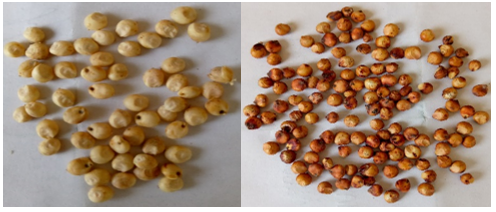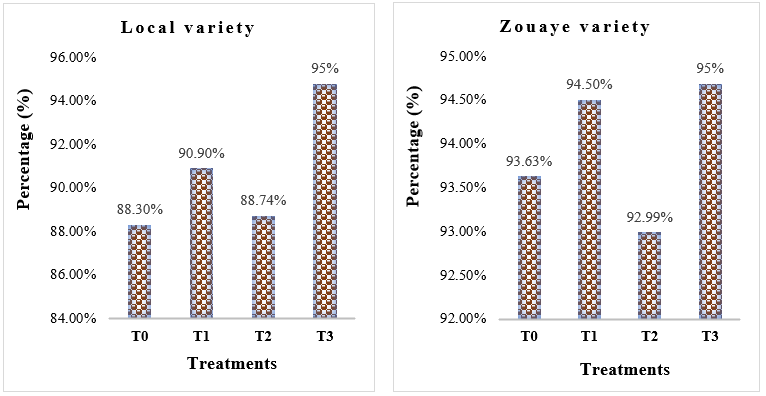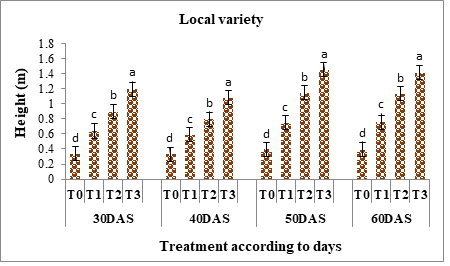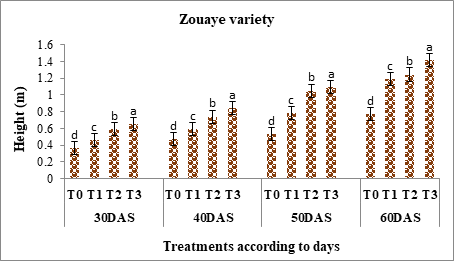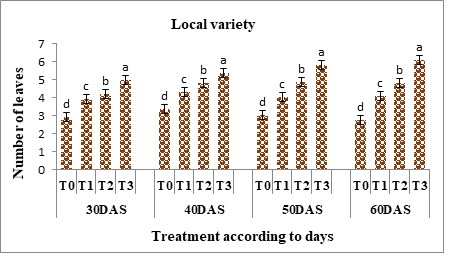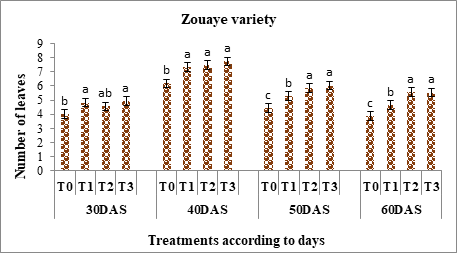Valorization Test of Organic Manure and Chemical Fertilizers on Growth Parameters of Two Varieties of Sorghum Bicolor (L.) in a Degraded Soil of Sudano-Sahelean Zone, Cameroon
- Bertrand Wang-Bara
- David Amedep
- Dieudonné Djackba Danra
- Adda Garoua Fatoumata
- Diko Abba Haicha
- 59-66
- Nov 5, 2023
- Agriculture
Valorization Test of Organic Manure and Chemical Fertilizers on Growth Parameters of Two Varieties of Sorghum Bicolor (L.) in a Degraded Soil of Sudano-Sahelean Zone, Cameroon
Bertrand Wang-Bara1*; David Amedep2; Dieudonné Djackba Danra3; Adda Garoua Fatoumata1; Diko Abba Haicha1
1Institute of Agricultural Research for Development (IRAD) of Garoua, Cameroon.
2Institute of Agricultural Research for Development (IRAD) of Ngaoundere, Regional Center of Wakwa, Cameroon.
3Department of Biological Sciences, Faculty of Sciences, University of Maroua, Cameroon.
*Corresponding Authors
DOI: https://doi.org/10.51584/IJRIAS.2023.81007
Received: 19 September 2023; Revised: 01 October 2023; Accepted: 05 October 2023; Published: 06 November 2023
ABSTRACT
In the Far-North region of Cameroon, where the population increases due to the demographic growth and consequently the demand in food is manifested considerably for the populations which are most focused on the agriculture practices. The peasants, who are the main actors of rural area are leads to the low productivity of cultures due to the poor crops management practices (the absence of cultures rotation) and the low soil fertility. This study was carried out at the Polyvalente Station of Agricultural Research of the North-Cameroon. The objective of this study was to evaluate the effects of chemical fertilizers associated with the organic manure on the growth parameters of Sorghum varieties (Local and Zouaye) in a degraded soil. Treatments were: T0 (0 kg of control); T1 (14 kg of poultry manure); T2 (2.4 kg of fertilizers 23-10-5+2Mgo +7.5S); T3 (14 kg of poultry manure + 2.4 kg of fertilizers 23-10-5+2Mgo +7.5S). The experimental design was a completely randomized blocks with 3 repetitions. The parameters evaluated were: the germination rate, the height and the diameters of plants. The results showed that the germination rate was important with the use of poultry manure and the association of both treatments for the two varieties of Sorghum. Referred to the control, the use of all substrates such as poultry manure, fertilizers and both treatments, significantly improves the height of plants for the varieties of Sorghum. However, the number of leaves emitted by these varieties was significant (P≤0.05) with the use of all substrates. The use of poultry manure, mineral fertilizers and the associated of substrates poultry manure + mineral fertilizers significantly improve the diameter of these varieties, compared to non-amended plots.
Key words: Fertilizers, Sorghum, Poultry manure, Degraded soils, Sudano-sahelean area.
INTRODUCTION
In the part of North of Cameroon, the cereals constitute a basis food of populations. This region has known since few years by the low productivity of cereals such as Sorghum, Maize and Rice (IRAD, 2012). The Sorghum (Sorghum bicolor (L.)) is one of the most cultivated cereals in the world and the most important for the millions of people in the semi-arid and arid tropics of Africa (Siene et al., 2019). In Africa, it comes third after maize and rice (Haicha et al., 2023; Comas & Gomez, 2002). It is one of the main foods in the poor regions of the world and where the food security is further threatened (Haicha et al., 2023).
Apart from human consumption, it is also used in animal feed, agro-food industry such as manufacture of alcoholic beverages, bread-making, biscuits (Siene et al., 2019). Its straw is used as animal fodder (Haicha et al., 2023). However, the low productivity of this culture encountered in the Septentrional zone of Cameroon is mainly due to the diseases attack during the growing stages of plants (coal disease), caterpillar attack on the field, the parasites attack (Striga sp), poor crop management practices, low soil fertility, extreme climatic conductions, the poverty of soils which has receives many cultures during the years. The crop environment is manipulated through agronomic management such as seed quality, plant population, and fertilizers, which influence the growth and ultimately the grain yield. Consequently, these soils are increasingly unproductive and, in extreme cases, degraded due to intensive cultures (monocultures) and the absence of crops rotation. In most degraded soils, the fertilization is not efficient for cultures due to the erosion of soils, the lack of incomes nutrients elements transported during harvest (Mukengere, 2010). The majority of these soils are leads to a low capacity of water retention and nutrients elements indispensable for the plant growth (Mukengere, 2010).
Many studies have focused at the importance of mineral fertilizer use (Siene et al., 2019; Nyembo et al., 2012). Their apply in a good time favor the growth and high productivity of cultures (Siene et al., 2019). However, their extreme use and considering the degraded soils of the Sudano-sahelean zone of Cameroon which leads to the decrease of organic matter, soil acidification, desaturation of the exchange complex, an increase in aluminum toxicity. In the face of this fact, it is suggested the use of organic manure for the restoration of soils and increase the productivity of cultures (Ilunga et al., 2016; Siene et al., 2019). In fact, the organic manure has very beneficial effects on the physico-chemical and biological properties of the soil and plays a very important role in mineral fertilization (Siene et al., 2019; Lompo, 2006). The organic matter is an important source of nutrients for plants (Wang-Bara et al., 2022; Siene et al., 2019; Koffié & Yéo, 2016). The use of organic fertilizers is, therefore, a key factor in the modernization of agriculture in developing countries. It is also beneficial on the physico-chemical and biological properties of the soils (Siene et al., 2019; Lompo, 2006). The general objective of this study is to evaluate the effect of the use of organic manure associated with mineral fertilizers on growth of two varieties of Sorghum in a degraded soil of North, Cameroon.
MATERIALS AND METHODS
Description of the site zone
The study was realized on the site of Polyvalente Station of Agricultural Research of North of Cameroon. The area is covered by the Sudano-Sahelean climate type, characterized by 2 seasons: a rainy season from May to September period, with heavy rains from July to August, followed by a cold season (October to January) and a warm dry season (February to April). Temperatures range from 30°C to 40°C. The vegetation of this area is dominated by Butyrospermum parkii, Tamarindus indica, Balanites aegyptiaca and herbaceous. The main cultivated crops are Millet (Pennisetum glaucum), Sorghum (Sorghum bicolor), Maize (Zea mays), Peanut (Arachis hypogea), Fonio (Digitaria sp), Cowpea (Vigna unguiculata), Bambara groundnut (Vigna subterranea).
Vegetal materials
For this experiment, the “Local variety” of Sorghum providing from the locality of this zone and the ameliorated seeds of Sorghum such as Zouaye variety were collected from the Institute of Agricultural Research for Development (IRAD) of Garoua. These varieties are considered like late with the cycle of development around 90 to 120 days.
(A) Local variety B) Zouaye variety
Figure 1: Varieties of Sorghum used (Local (A) and Zouaye (B)).
Test implementation
The soil preparation consists to doing plowing process and delimitation of experimental units. Soil labor was made at 25 cm of depth and also treatment of soil was done with herbicides for kill weeds in unit plots. Spreading substrates (poultry manure + mineral fertilizers) was quantified and done two weeks before sowing of different cultures. After two weeks, mineral fertilizers NPK 23-10-5+2Mgo +7.5S was applied for good growing of plants in field.
Fertilizers used
The fertilizers used are constituted of recommended mineral fertilizers NPK (23-10-5+2Mgo +7.5S) of dose of 100 kg and urea (45 % N) for 1ha and chicken manure in reason of 70 g per units of 20 m2. The application dose of 2.4 kg of chemical fertilizers was applied per unit on field for the Sorghum varieties culture (Local and Zouaye). The organic manure as chicken manure is used in reason of 70 g per plants for the density of 174 plants per unit for the cereals. The quantities of 14 kg of chicken manure were applied per unit which receives this substrate.
Experimental design
The experimental design was a block completely randomized with 3 repetitions and fourth treatments including control (T0), chicken manure (T1), Fertilizers types 23-10-5+2Mgo +7.5S (T2) and chicken manure + fertilizers (T3). Every block is divided in sub-blocks arranged at the distance of 0.5 and each unit measure 4 m x 10 m=20 m2 for the cereals culture. Before sowing, soil was labor at 25 cm of depth. Sowing process was done two weeks after with 80 cm of distances between lines and 25 cm between pockets. The total number of plants per unit was 174. The seeds were sowed in soil approximatively at 5 cm depth and weeds were sprayed in every unit considered. Spraying after sowed with pesticide was realized at thirteen weeks against attacks of plants by others insects.
Treatments
The applied quantities of different substrate (chicken manure and mineral fertilizers) were measured with a scale (Table 1). Treatments are control without any substrate (T0), poultry manure (T1), fertilizers 23-10-5+2Mgo +7.5S (T2) and the association of substrate (T3). Before sowing, 14 kg of organic manure (chicken manure) were applied on all experimental units which receives poultry manure. However, fertilizers types 23-10-5+2Mgo +7.5S+ urea (45 % N) were applied in reason 2.4 kg on units which receives mineral
fertilizers 2 weeks after sowing.
Table 1: Applied treatments and control.
| Treatment code | Treatments | Doses |
| T0 | Control | 0 kg |
| T1 | Chicken manure | 14 kg |
| T2 | Fertilizers 23-10-5+2Mgo +7.5S | 2.4 kg |
| T3 | Chicken manure+ Fertilizers 23-10-5+2Mgo +7.5S | 14 kg+2.4 kg |
Parameters assessment
Germination rate of cereals
The germination rate was evaluated on the field. The number of germinated plants and not germinated plants were counted in order to determine the rate of plants, which are germinated per units for different treatment and control. Data were collected from 10th days after sowing (DAS) on 15 plants takes like reference for measure.
Total numbers of pocket = number of germinated pockets + number of empty pockets.
Height of plants
The growing of plants determination consists to measure with decameter the height of 15 plants takes like reference at the interval of 10 days. Data were collected for every treatment and control on four sampling campaigns, 30th DAS, 40th DAS, 50th DAS, and 60th DAS.
Number of leaves
The number of leaves was counted on every plant reference of 15 plants. It is consisting to determine the number of leaves for each treatment considered at the interval 10 days on four sampling campaigns, 30th DAS, 40th DAS, 50th DAS, and 60th DAS.
Diameter of plants
The diameter of plants was measure with caliper on every 15 plants reference for all treatments at the interval 10 days on four sampling campaigns, 30th DAS, 40th DAS, 50th DAS, and 60th DAS.
Statistical analysis
Data of growing and yields were performed using ANOVA test with software R-cmdr. Significances average separation were done with the test of Tukey at the probability of 5 %.
RESULTS AND DISCUSSIONS
Germination rates of Sorghum varieties
The germination rate of the two varieties of Sorghum (Local and Zouaye) in the amended plots was higher compared to the control plots (Figure 2a and 2b). The use of poultry manure and the combined effect of both treatments favor the germination rate of the two varieties of Sorghum compared to non-amended plots. They vary respectively of 90.90 % (poultry manure) and 95 % (poultry manure + fertilizers) for the “Local variety” and followed by the germination rate of 94.5 % (poultry manure) and 95 % (poultry manure + fertilizers) for the ameliorated Zouaye variety.
Figure 2a: Local variety Figure 2b: Zouaye variety
(T0 = control; T1 = poultry manure; T2 = fertilizers 23-10-5+2Mgo +7.5S; T3 = poultry manure + fertilizers 23-10-5+2Mgo +7.5S).
Height and the number of leaves of Sorghum varieties
The Figure 3a and 3b shows the effect of different treatment on the height of plants at 30th, 40th, 50th and 60th DAS of Sorghum varieties. The height of plants increased during the growing stages of Sorghum varieties. Compared to the control plots (T0), the growth of plants was significant (P≤0.05) from 30th DAS to 60th DAS by the use of poultry manure (T1), chemical fertilizers (T2) and both treatments (T3). The apply of all treatments enhance the height of plants during their growing for the “Local variety” (Figure 3a). Similarly, in comparison within the two varieties and referring to the control (T0), the same results were also recorded with the ameliorated variety (Zouaye) where the use of different fertilizers like substrates significantly (P≤0.05) improve the height of plants during their development for all treatments applied (Figure 3b).
The Figure 4a and 4b illustrates the effect of different treatments on the number of leaves at 30th, 40th, 50th and 60th DAS of Sorghum varieties. The number of leaves was enhanced during the growth of plants. In comparison to the control plots (T0), the number of leaves was significant (P≤0.05) from 30th DAS to 60th DAS by the use of poultry manure (T1), fertilizers (T2) and the association of poultry manure + chemical fertilizers (T3). These substrates applied favor the appearance of plants leaves during the development stages for the “Local variety” (Figure 4a). In comparison between the two varieties and referred to the control treatment, the same results were more observed with the ameliorated variety (Zouaye) where the use of all treatments were more significant (P≤0.05) and improve the number of leaves emitted during the growth of plants from 40th DAS to 60th DAS (Figure 4b).
Figure 3a: Height of plants of Local variety. Figure 3b: Height of plants of Zouaye variety.
Figure 4a: Number of leaves of Local variety. Figure 4b: Number of leaves of Zouaye variety.
Stem diameter of Sorghum varieties
The Figure 5a and 5b illustrates the effect of different treatments on the diameter of plants at 30th, 40th, 50th and 60th DAS of Sorghum varieties. The diameter of plants was increase during the growth of plants Sorghum. Compared to the control plots (T0), the diameter of plants was significant (P≤0.05) with all the treatments applied during the experimental essay. That suggest the use of poultry manure (T1), chemical fertilizers (T2) and the association of poultry manure + chemical fertilizers (T3) were good for the diameter of plants for the “Local variety” (Figure 5a). The same results were also obtained by the use of different fertilizers on the diameter of plants for the ameliorated variety of Sorghum (Zouaye), where all treatments were enhanced their diameters during the growth of plants (Figure 5b).
Figure 5a: Stem diameters of plants of Local variety. Figure 5b: Stem diameters of plants of Local variety.
(T0 = control; T1 = poultry manure; T2 = fertilizers types 23-10-5+2Mgo +7.5S; T3 = poultry manure + fertilizers types 23-10-5+2Mgo +7.5S).
DISCUSSIONS
At the start of this study, we evaluate the germination rate of Sorghum on the field. We recorded a variation among the different substrates used. The germination rate of “Local variety” of Sorghum was most suitable with the use of poultry manure and the association of both treatments (poultry manure + fertilizers), compared to the non-amended plots. Also, for the ameliorated “Zouaye variety” of Sorghum, the same treatments applied considerably improve de germination rate of plants. These substrates have a good effect for the germination rate of plants on this locality (degraded soil). Our works corroborate with the results of Nyembo et al. (2012), which found that the different doses of fertilizers on the yields of Maize enhance the germination rate of plant. Also, the works of Wang-Bara et al. (2021) on the organic amendment of Maize and Sorghum plants ameliorate the germination rate of plants.
The results showed that the height of plants of “Local variety” of Sorghum significantly increase with the supply of all substrates, such as the poultry manure, fertilizers and both treatments, referring to the control plots. In comparison to the ameliorated “Zouaye variety” of Sorghum and referring to the non-amended plots, the same results were also recorded on the growing of height of plants. That prove the positive effect of all substrates in the growth on height of plants in this area. Ours results are similar to the works of Tshibingu et al. (2017), founded a good growing on the height of plants of Maize in the plots which receives the fertilizers (organic matter or mineral fertilizers) compared to the control plots. The apply of organic manure in poor soils considerably favor the penetration of plant-roots, the circulation of air or water in the soil and the formation and maintenance of the Argilo-Humic Complex of soils (Wang-Bara et al., 2021; Amadji and Migan, 2001). The nutrient elements (Phosphorous, Nitrogen) are available through the decomposition and mineralization of organic manure and which is important for the growth of plants (Wang-Bara et al., 2021; Laminou, 2010).
The number of leaves emitted by the “Local variety” of Sorghum were most significant with the use of poultry manure, fertilizers and the association of both treatments (poultry manure + fertilizers). However, in comparison to the ameliorated “Zouaye variety” of Sorghum and referring to the control plots, the same results were also obtained by the applied of all treatments on the appearance of leaves during the vegetative stages. That suggest the good effect of organic and mineral fertilizers on the development of plants. However, the works of Wang-Bara et al. (2022) on the organic amendment of two varieties of Rice showed a good effect on the tillage of plants. We could suggest that the use of organic manure associated with a certain quantity of chemical fertilizers ameliorate the availability of nutrients for the cultures and mostly provides to the decomposition of organic amendment for a good vegetative recover of plants during their development (Wang-Bara et al., 2022).
The use of poultry manure, fertilizers and the associated of substrate of poultry manure + fertilizers significantly improve the diameter of plants of the “Local variety” of Sorghum referring to the non-amended plots. In comparison to the ameliorated “Zouaye variety” of Sorghum and referring to the control plots, the applied of all treatments have also a good effect to the growth of plants on the stem diameter of plants. According to the works of Metouchi and Yahia (2020), the plant growth of Phaseolus vulgaris with the supply of organic manure enhance the diameter of plants and the number of fruits during the maturation. Also, the works of Wang-Bara et al. (2021) and Aristil (2019) on the organic fertilization of Sorghum bicolor showed that the variations of the stem diameters depend on the levels and fertilizers types used.
CONCLUSION
The results of our works on the valorization of the organic manure and mineral fertilizers on the germination rate and the growth parameters of two varieties of Sorghum bicolor (L.) in the degraded soils of Sudano-sahelean zone showed a good response on the germination rate with the poultry manure and both treatments. The applied of all substrates such as poultry manure, fertilizers and both treatments significantly improve the height of plants for the two varieties of Sorghum (Local and Zouaye variety). The number of leaves emitted by the two varieties of Sorghum was most significant (P≤0.05) with the use of all substrates, compared to the non-amended plots. The stem diameter of plants of the two varieties of Sorghum bicolor (L.) was most ameliorated with the applied of all substrates such as the poultry manure, fertilizers and both treatments, compared to the control plots.
ACKNOWLEDGEMENTS
Authors are grateful Institute of Agricultural Research for Development (IRAD), Multipurpose Station of Agricultural Research of Garoua and Regional Center of Wakwa, Cameroon. Authors acknowledge also the staff of the University of Maroua and Ngaoundéré, Cameroon for their kind collaboration with researchers for the realization of this study.
REFERENCES
- Amadji G. L & Migan D. Z. (2001). Influence d’un amendement organique (compost) sur les propriétés physico-chimiques et la productivité d’un sol ferrugineux tropical. Annales des Sciences Agronomiques du Bénin ; 2 :123-139p.
- Aristil J. (2019). Effets de trois types de fertilisants sur les paramètres végétatifs et productifs du Sorgho en Haïti. Int. J. Biol. Chem. Sci ;13 : (2) ; 720-726p.
- Haicha D. A., Adoul Aziz S., Wang-Bara B., Fatoumata A., Lendzemo V. (2023). Evaluation participative de douze variétés élites de Sorgho repique dans trois localités de l’Extrême-Nord Cameroun. International Journal of Innovation Scientific Research and Review; Vol. 05, Issue, 04, pp.4398-4401.
- Ilunga T. H., Sadiki M. P., Tshibuyi K. , Nsenga N. S., Mazinga K. M., Nyembo K. L. & Baboy L. L. (2016). Les faibles doses de biomasses vertes de légumineuses, des bons substituts des engrais minéraux dans la maïsiculture à Lubumbashi ; Afrique Science ;12 (2) : 317-325p.
- Koffié B & Yéo L. (2016). Revue de géographie, d’aménagement régional et de développement « Maraîchage urbain et sécurité sanitaire des aliments à Korhogo » 2 p.
- Laminou M. O. (2010). Fixation des dunes dans le sud-est du Niger : Evaluation de l’efficacité de la barrière mécanique, espèces ligneuses adaptées et potentialités d’inoculation mycorhizienne. Thèse de Doctorat, Université de Liège, Liège, Belgique ;1-158p.
- Lompo D. P. (2006). Gestion de la fertilité des sols dans les systèmes de culture de l’ouest du Burkina Faso : Evaluation des effets agronomiques et de rentabilité économique de trois formules de fumure. Mémoire de fin d’études IDR, Université Polytechnique de Bobo Dioulasso, 1-60 p.
- Metouchi I & Yahia L. (2020). Evaluation de l’effet d’engrais organique sur l’expression végétative du Haricot : cas de la biomasse du romarin et pin pignon ; Mémoire de Master. 1-69p.
- Mukengere B. E. (2010). Evaluation de l’efficacité d’usage des engrais dans les sols dégradés du Sud-Kivu sur la culture du Maïs et du Haricot. Cas du groupement de Burhale. Mémoire inédit, UEA : 1-59pp.
- Nyembo K. L., Useni S. Y., Mpundu M. M., Bugeme M. D., Kasongo L. E., Baboy L. L. (2012). Effets des apports des doses variées de fertilisants inorganiques (NPKS et Urée) sur le rendement et la rentabilité économique de nouvelles variétés de Zea mays (L.) à Lubumbashi, Sud Est de la RD Congo. Journal of Applied Biosciences 59 : 4286-4296p.
- Siene L. A. C., Kouame K., Coulibaly L. F., Vatiemon D., Kouadio A. B. (2019). Effects of Two Different Types of Mineral and Organic Fertilizers on Morphological Characteristics and Yield of a Variety of Millet (Pennisetum glaucum), Cultivated in the Region of Korhogo. SSRG; International Journal of Agriculture & Environmental Science (SSRG-IJAES)-Volume 6 Issue 3; ISSN: 2394-2568.
- Tshibingu R. M., Mukadi T. T., Mpoyi B. M., Ntatangolo B. M., Musenge D. K., Tshibingu M. I., Kazadi J. N., Nyembo D. N., Mushambani T. M. (2017). Évaluation de la productivité du Maïs (Zea mays (L.)) sous amendements organique et minéral dans la province de Lomami, République Démocratique du Congo. Journal of Applied Biosciences ; 109 :10571-10579p.
- Wang-Bara B., Ahmed H., Amedep D., Ramatou L. A., Kaouvon P and Guidjinga Kanpetta N. A. (2022). Effect of organic amendment (Biochar and Compost) on growth and yields of two varieties of Rice (Oryza sativa (L.)) in Ngaoundere, Cameroon. International Journal of Science Academic Research; Vol. 03, Issue 04, pp.3661-3666.
- Wang-Bara B., Danra D. D., Ahmed H., Amedep D., Housseini D. J. (2022). Comparative effects of poultry manures and mycorrhiza on growth parameters and yields of Peanut (Arachis hypogea (L.)) in a Sudano-Sahelean area of Cameroun (Yagoua, Far-North region). International Journal of Research and Scientific Innovation (IJRSI)/Volume IX, Issue III/ISSN 2321-2705.
- Wang-Bara B., Kaouvon P., Housseini D. J., Alioum S. P and Danra D. D. (2021). Effects of Fertilization Based on Chicken Manures and Mycorrhiza on Vegetative Parameters and Phenological Stages of Sorghum bicolor in Yagoua, Far-North Cameroon. 33(24): 375-383pp, Article no. IJPSS.67170; ISSN: 2320-7035p.

